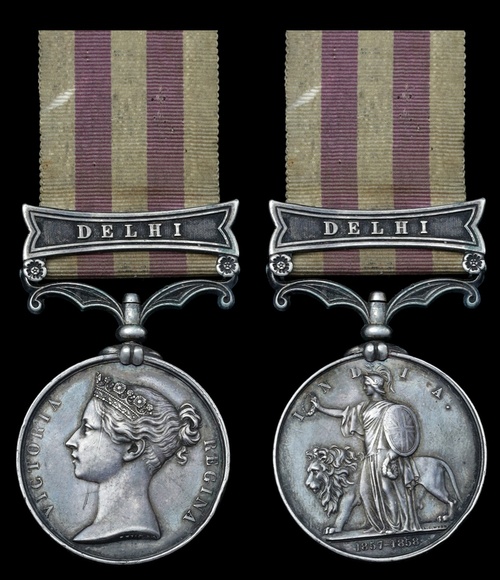
Auction: 19003 - Orders, Decorations and Medals
Lot: 14
Indian Mutiny 1857-59, 1 clasp, Delhi (J. Young 61st Regt.), original riband, minor edge bruises, toned, very fine
James Young, a Coventry man, joined the 54th (West Norfolk) Regiment of Foot on 26 August 1841. He served with them until 31 March 1849, when he transferred to the 61st (South Gloucestershire) Regiment. His discharged papers state: 'Served at the Siege and Capture of Delhi in 1857. Present at the repulse of the sortie of 24th July and at the action of Nujuffghur on 25th August 1857.' A wing of the 61st, including Young, had joined the British besiegers on the ridge before Delhi on 1 July 1857. It was not until 14 August that the remainder of the 61st arrived, part of Brigadier John Nicholson's Punjab Moveable Column. On 23 July, a large force of rebels sallied from Kashmir Gate and tried to capture Ludlow Castle, a strongpoint in the British entrenchments. They were thrown back at a cost of some 50 British casualties. This is the 'sortie' referred to in Young's discharge papers.
The Battle of Nujuffghur on 25 August was even more critical. Some 8,000 rebels sallied from the city and attacked the rear of the British besieging force. This rebel movement was quickly spotted and deftly repelled by Nicholson. It was raining heavily, and the rebels were badly led. They withdrew to the village of Nujuffghur, setting up camp there. Nicholson personally led his troops across a deep stream and formed them up in two lines. The advance was sounded, and the troops charged across 200 yards of mud and water in plain view of the enemy. The 61st Foot took part in this charge, supporting the 2nd Punjab Infantry on the right flank. By the end of the battle, all rebel guns had been captured and a severe blow was dealt to rebel morale.
The 61st Foot were assigned to Brigadier Longfield's 5th Column in the final attack on Delhi on 14 September, along with Wilde's Rifles and a wing of the Belooch Battalion. Nicholson was mortally wounded during the assault, but the attack succeeded and Delhi was recaptured. Young was discharged at Chatham on 7 June 1859, on account of chronic deafness and tarsitis of both eyes. He became an Out-Pensioner of the Royal Hospital, Chelsea, returning to Coventry and taking up work as a fish dealer. The 1871 census shows him married with four children. He was buried on 9 December 1883 at London Road Cemetery, Coventry; sold with copied service papers, census records and research.
Subject to 20% VAT on Buyer’s Premium. For more information please view Terms and Conditions for Buyers.
Sold for
£420
Starting price
£210




